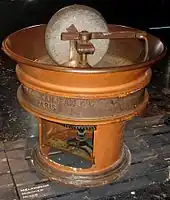Melanger
A melanger (or melangeur, from French: mélangeur, lit. "blender") is a stone-grinder that is used in chocolate-making. It typically consists of two granite wheels, which rotate inside a metal drum on top of a granite base. Given enough time the wheels can reduce the particles to sizes measured in microns, therefore making a smooth chocolate paste from cocoa beans.

Stone grinding tools have been widely used in history to make food. In Mesoamerica, cocoa was ground using a metate. Industrialization in the late 18th century favored the use of larger and water powered machines. Philippe Suchard is generally credited for the introduction of the first modern melanger in 1826. He opened a chocolate factory in Neuchâtel where he used a melanger to grind cocoa and sugar.[1][2]
Nowadays melangers tend to be used by small chocolate manufacturers only.[3] Melangers can be both used as refiners and conches.[4]
Tabletop wet grinders are smaller versions of the melanger.
 Ancient melanger used in the Cailler factory |
.jpg.webp) Ancient melanger used in a Spanish factory |
See also
References
- Barel, Michel (2021). Du cacao au chocolat: L'épopée d'une gourmandise. Éditions Quæ. p. 102. ISBN 9782759233793.
En 1826, Philippe Suchard ouvre une chocolaterie à Serrière, près de Neuchâtel, en Suisse. Il met au point une machine à meules pour mélanger le sucre et le cacao. C'est un immense progrès.
[In 1826, Philippe Suchard opened a chocolate factory in Serrière, near Neuchâtel, Switzerland. He develops a millstone machine to mix sugar and cocoa. This is a huge progress.] - Collins, Ross F. (2022). Chocolate: A Cultural Encyclopedia. ABC-CLIO. p. 114.
Philippe Suchard, who in 1826 established an industrial chocolate operation in Switzerland, invented a machine using granite rollers revolving over a slab to break the particles into an ever-finer size until they reached the goal of less than 30 microns.
- Making Chocolate: From Bean to Bar to S'more: A Cookbook. Clarkson Potter/Ten Speed. 2017. p. 84. ISBN 9780451495365.
Melangers typically have a smaller capacity than other industrial mills, so most large makers don't use them; Hershey did, but abandoned them in the 1950s for larger-capacity ball mills. This was about the same time that the electric motor reached India, where melangers were co-opted for making dosas...
- O'Sullivan, Maurice (2016). A Handbook for Sensory and Consumer-Driven New Product Development: Innovative Technologies for the Food and Beverage Industry. Woodhead Publishing. p. 310.
'Conching' is a very important mixing step in chocolate flavour development. Small-scale conching uses a melangeur or refiner conche...